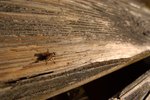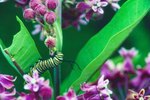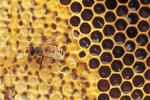
Little is known about the elusive Phasmatodea order of insects, or walking sticks as they are commonly referred to in the United States, but this large, elongated "stick-like" insect can have beneficial and detrimental effects on the environment. Its inherent camouflaging ability, used to defend itself from predators, is partly to blame for any negative environmental impact.
Walking Stick Features

The walking stick is an intriguing but relatively rare sight due to crypsis, a natural adaption that enables the insect to match its surroundings. Walking sticks easily blend into the green, brown or grayish colors of their vegetative habitat, making them hard to find. The fact that walking sticks can go undetected for some time before discovery can occasionally lead to significant defoliation of trees and shrubs, even though they also make a positive contribution to the environment.
Walking Stick Environmental Benefits
Walking sticks are herbivores that enjoy dining on the leaves of deciduous trees and shrubs such as oak, rose, rhododendron, ivy, eucalyptus, apple and strawberry. Their feeding activity may be beneficial because they prune foliage, encouraging new plant growth. According to ZipcodeZoo.com, scientists view walking sticks as dominant light gap herbivores in South America. They lower the growth of early successional plants by consuming them, and through defecation, augment nutrients in the soil available to later successional plants. By ensuring that earlier plants cannot swiftly immobilize soil nutrients in light gaps, new substantial growth and forest recycling is sustained.
Walking Stick Plant Damage

In the United States, walking stick populations are relatively low so damage to plants is limited. However, notable damage has occurred to plants in southernmost states, where walking sticks are more prevalent. According to the University of California Division of Agriculture and Natural Resources, the Carausius morosus species, commonly referred to as the Indian walking stick, is mostly a nuisance pest, but the insect has also caused serious damage to California landscaping.
Tattered and missing leaves in landscaping reduce curb appeal and may incur financial loss. In the tropics, where walking sticks are abundant, they have caused severe defoliation of forest trees, resulting in tree death, animal habitat destruction and economic loss.
Walking Stick Environmental Impact
The environmental significance of walking sticks is a mixed bag in that the insect's feeding habits may have a beneficial role in the environment -- or at least a neutral effect. Defoliation in temperate climates is limited, and when it does occur, plants can usually recover. But the insect has also had a detrimental environmental impact through severe tree defoliation, most often occurring in tropical and subtropical regions. This ambiguity lends itself well to the mysterious nature of this transformative creature.
References
Photo Credits
-
Hemera Technologies/Photos.com/Getty Images
Writer Bio
A metropolitan Washington, D.C. resident, Bridget Cipollini has been writing professionally for more than 15 years. She received a Bachelor of Arts in journalism from Indiana University of Pennsylvania in 1986. She is a passionate advocate for animals and has volunteered for pet rescue and adoption organizations.




